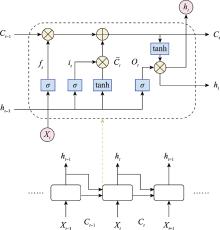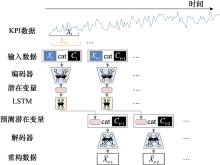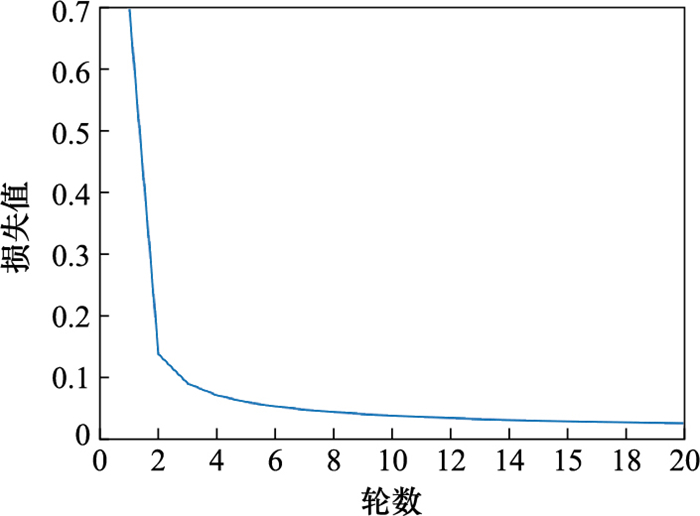Systems Engineering and Electronics ›› 2025, Vol. 47 ›› Issue (3): 1019-1027.doi: 10.12305/j.issn.1001-506X.2025.03.34
• Communications and Networks • Previous Articles
Server KPI anomaly detection based on CVAE-LSTM
Xiarun SHEN1,*, Ruonan LI2, Haotian ZHANG3
- 1. Beijing Institute of Aerospace Information, Beijing 100854, China
2. Patent Examination Cooperation (Beijing) Center of The Patent Office, Beijing 100070, China
3. Sino-German College of Applied Sciences at Tongji University, Shanhai 201804, China
-
Received:2023-05-11Online:2025-03-28Published:2025-04-18 -
Contact:Xiarun SHEN
CLC Number:
Cite this article
Xiarun SHEN, Ruonan LI, Haotian ZHANG. Server KPI anomaly detection based on CVAE-LSTM[J]. Systems Engineering and Electronics, 2025, 47(3): 1019-1027.
share this article
Table 3
Parameters setting of CVAE-LSTM"
| 模块名称 | 层操作名称 | 参数设置 | 输出维度 | 上一层操作 |
| Encoder | input(InputLayer) | - | (batch, 139) | - |
| linear_1(Linear) | (139, 100, bias=True) | (batch, 100) | input | |
| activation_1(ReLU) | - | (batch, 100) | linear_1 | |
| linear_2(Linear) | (100, 100, bias=True) | (batch, 100) | activation_1 | |
| activation_2(ReLU) | - | (batch, 100) | linear_2 | |
| linear_3(Linear) | (100, 8, bias=True) | (batch, 8) | activation_2 | |
| linear_4(Linear) | (100, 8, bias=True) | (batch, 8) | activation_2 | |
| activation_3(Softplus) | beta=1, threshold=20 | (batch, 8) | linear_4 | |
| LSTM | lstm_1(LSTM) | (8, 64, batch_first=True) | (batch, k, 64) | linear_3 |
| lstm_2(LSTM) | (64, 8, batch_first=True) | (batch, k, 8) | lstm_1 | |
| Decoder | linear_5(Linear) | (99, 100, bias=True) | (batch, 99) | lstm_2 |
| activation_4(ReLU) | - | (batch, 100) | linear_5 | |
| linear_6(Linear) | (100, 100, bias=True) | (batch, 100) | activation_4 | |
| activation_5(ReLU) | - | (batch, 100) | linear_6 | |
| linear_7(Linear) | (100, 48, bias=True) | (batch, 48) | activation_5 | |
| linear_8(Linear) | (100, 48, bias=True) | (batch, 48) | activation_5 | |
| activation_6(Softplus) | beta=1, threshold=20 | (batch, 48) | linear_8 |
Table 3
Table 4
Result of contrast experiment %"
| 数据集 | 性能 | LSTM-AD | VAE | CVAE | PUAD | 本文模型 |
| A | Precision | 78.67 | 94.19 | 92.57 | 97.39 | 100.00 |
| Recall | 82.31 | 82.71 | 91.78 | 92.12 | 92.35 | |
| F1 | 80.44 | 88.08 | 92.17 | 94.68 | 96.02 | |
| B | Precision | 58.25 | 91.96 | 93.51 | 95.67 | 99.91 |
| Recall | 54.27 | 100.00 | 100.00 | 99.94 | 99.05 | |
| F1 | 56.19 | 95.81 | 96.65 | 97.76 | 99.47 | |
| C | Precision | 72.00 | 99.21 | 97.91 | 96.42 | 98.32 |
| Recall | 69.83 | 79.09 | 88.36 | 88.10 | 88.36 | |
| F1 | 70.90 | 88.02 | 92.89 | 92.07 | 93.07 |
Table 4
| 1 | 张圣林, 林潇霏, 孙永谦, 等. 基于深度学习的无监督KPI异常检测[J]. 数据与计算发展前沿, 2020, 2 (3): 87- 100. |
| ZHANG S L , LIN X F , SUN Y Q , et al. Research on unsupervised KPI anomaly detection based on deep learning[J]. Frontiers of Data and Computing, 2020, 2 (3): 87- 100. | |
| 2 | YE Q L , YANG J , YIN T M , et al. Can the virtual labels obtained by traditional LP approaches be well encoded in WLR?[J]. IEEE Trans.on Neural Networks and Learning Systems, 2015, 27 (7): 1591- 1598. |
| 3 | CHANDOLA V , BANERJEE A , KUMAR V . Anomaly detection: a survey[J]. ACM Computing Surveys (CSUR), 2009, 41 (3): 1- 58. |
| 4 | RINGBERG H, SOULE A, REXFORD J, et al. Sensitivity of PCA for traffic anomaly detection[C]//Proc. of the Measurement and Modeling of Computer Systems, 2007. |
| 5 | PENA E H M, ASSIS M V O, PROENCA M L. Anomaly detection using forecasting methods ARIMA and HWDS[C]//Proc. of the 32nd International Conference of the Chilean Computer Science Society, 2013: 63-66. |
| 6 | NADAI M D, SOMEREN M V. Short-term anomaly detection in gas consumption through ARIMA and artificial neural network forecast[C]//Proc. of the IEEE Workshop on Environmental, Energy, and Structural Monitoring Systems, 2015: 250-255. |
| 7 | CHEN Y, MAHAJAN R, SRIDHARAN B, et al. A provider-side view of web search response time[C]//Proc. of the ACM Special Interest Group on Data Communication, 2013. |
| 8 | LAPTEV N, AMIZADEH S, FLINT I. Generic and scalable framework for automated time-series anomaly detection[C]//Proc. of the Knowledge Discovery and Data Mining, 2015. |
| 9 | LIU D P, ZHAO Y J, XU H W, et al. Opprentice: towards practical and automatic anomaly detection through machine learning[C]//Proc. of the Internet Measurement Conference, 2015: 211-224. |
| 10 | BREUNIG M M, KRIEGEL H P, NG R T, et al. LOF: identifying density-based local outliers[C]//Proc. of the ACM SIGMOD International Conference on Management of Data, 2000: 93-104. |
| 11 | AMER M, GOLDSTEIN M, ABDENNADHER S. Enhancing one-class support vector machines for unsupervised anomaly detection[C]//Proc. of the ACM SIGKDD Workshop on Outlier Detection and Description, 2013: 8-15. |
| 12 | ERFANI S M , RAJASEGARAR S , KARUNASEKERA S , et al. High-dimensional and large-scale anomaly detection using a linear one-class SVM with deep learning[J]. Pattern Recognition, 2016, 58, 121- 134. |
| 13 | LIU F T, TING K M, ZHOU Z H. Isolation forest[C]//Proc. of the 8th IEEE International Conference on Data Mining, 2008: 413-422. |
| 14 | MUNZ G, LI S, CARLE G. Traffic anomaly detection using k-means clustering[C]//Proc. of the GI/ITG Workshop MMBnet, 2007. |
| 15 | MALHOTRA P, VIG L, SHROFF G, et al. Long short term memory networks for anomaly detection in time series[C]//Proc. of the European Symposium on Artificial Neural Networks, 2015: 89-94. |
| 16 | AN J W , CHO S Z . Variational autoencoder based anomaly detection using reconstruction probability[J]. Special Lecture on IE, 2015, 2 (1): 1- 18. |
| 17 | ZONG B, SONG Q, MIN M R, et al. Deep autoencoding Gaussian mixture model for unsupervised anomaly detection[C]// Proc. of the International Conference on Learning Representations, 2018. |
| 18 | XU H W, CHEN W X, ZHAO N W, et al. Unsupervised anomaly detection via variational auto-encoder for seasonal KPI in web applications[C]//Proc. of the World Wide Web Conference, 2018: 187-196. |
| 19 | LI Z Y, CHEN W X, PEI D. Robust and unsupervised KPI anomaly detection based on conditional variational autoencoder[C]// Proc. of the IEEE 37th International Performance Computing and Communications Conference, 2018. |
| 20 | SRIVASTAVA N , HINTON G , KRIZHEVSKY A , et al. Dropout: a simple way to prevent neural networks from overfitting[J]. The Journal of Machine Learning Research, 2014, 15 (1): 1929- 1958. |
| 21 | IOFFE S, SZEGEDY C. Batch normalization: accelerating deep network training by reducing internal covariate shift[C]//Proc. of the International Conference on Machine Learning, 2015: 448-456. |
| 22 | LIN S, CLARK R, BIRKE R, et al. Anomaly detection for time series using VAE-LSTM hybrid model[C]//Proc. of the ICASSP IEEE International Conference on Acoustics, Speech and Signal Processing, 2020: 4322-4326. |
| 23 | KINGMA D P, WELLING M. Auto-encoding variational Bayes[EB/OL]. [2023-04-11]. https://arXiv.org/abs/1312.6114. |
| 24 | SOHN K, LEE H, YAN X. Learning structured output representation using deep conditional generative models[C]//Proc. of the Advances in Neural Information Processing Systems, 2015. |
| 25 | HOCHREITER S , SCHMIDHUBER J . Long-shortterm memory[J]. Neural Computation, 1997, 9 (8): 1735- 1780. |
| 26 | LI Z Y, ZHAO N W, ZHANG S L, et al. Constructing large-scale real-world Benchmark datasets for AIOps[EB/OL]. [2023-04-11]. https://arXiv.org/abs/2208.03938. |
| 27 | ZHANG S L, ZHAO C Y, SUI Y C, et al. Robust KPI anomaly detection for large-scale software services with partial labels[C]// Proc. of the IEEE 32nd International Symposium on Software Reliability Engineering, 2021: 103-114. |
| [1] | Xiaolin LIU, Mengjiao GUO, Zhuo LI. Adaptive graph convolutional recurrent network prediction method for flight delay based on Dueling DQN optimization [J]. Systems Engineering and Electronics, 2025, 47(2): 568-579. |
| [2] | Weihong FU, Xinyu ZHANG, Naian LIU. Single-channel blind source separation algorithm for co-frequency and co-modulation based on multi-scale fusion neural network [J]. Systems Engineering and Electronics, 2025, 47(2): 641-649. |
| [3] | Wei CAI, Xin WANG, Xinhao JIANG, Zhiyong YANG, Dong CHEN. Research on few shot target detection method based on decoupling [J]. Systems Engineering and Electronics, 2024, 46(9): 2941-2950. |
| [4] | Xiaoxuan CHEN, Shuwen XU, Shaohai HU, Xiaole MA. Infrared and visible light image fusion based on convolution and self attention [J]. Systems Engineering and Electronics, 2024, 46(8): 2641-2649. |
| [5] | Qianglong WANG, Xiaoguang GAO, Bicong WU, Zijian HU, Kaifang WAN. Review of research on restricted Boltzmann machine and its variants [J]. Systems Engineering and Electronics, 2024, 46(7): 2323-2345. |
| [6] | Xiantao SUN, Wangyang JIANG, Wenjie CHEN, Weihai CHEN, Yali ZHI. Object grasp pose detection based on the region of interest [J]. Systems Engineering and Electronics, 2024, 46(6): 1867-1877. |
| [7] | Xuemei CHEN, Zhiheng LIU, Suiping ZHOU, Hang YU, Yanming LIU. Road extraction from high-resolution remote sensing images based on HRNet [J]. Systems Engineering and Electronics, 2024, 46(4): 1167-1173. |
| [8] | Tianwen ZHANG, Xiaoling ZHANG, Zikang SHAO, Tianjiao ZENG. Mask attention interaction for SAR ship instance segmentation [J]. Systems Engineering and Electronics, 2024, 46(3): 831-838. |
| [9] | Junyang GONG, Weihong FU, Naian LIU. Design of SAR image target contour enhancement preprocessing module [J]. Systems Engineering and Electronics, 2024, 46(12): 4010-4017. |
| [10] | Tong OUYANG, Ling WANG, Daiyin ZHU, Yong LI. Fine-grained recognition method for meteorological targets in ResNeXt fused with LightGBM [J]. Systems Engineering and Electronics, 2024, 46(12): 4034-4043. |
| [11] | Ke PENG, Huawei WANG, Zhaoguo HOU, Xiaohan ZENG, Tong LUO. Decision support method of ATC special situation disposal based on knowledge graph [J]. Systems Engineering and Electronics, 2024, 46(12): 4116-4127. |
| [12] | Ran JI, Maosen XIAO, Shuo LI, Yu LIU, Zhanyi LUO, Jiawei CHENG. Research on MRTD objective testing method based on machine learning [J]. Systems Engineering and Electronics, 2024, 46(10): 3265-3270. |
| [13] | Qianqi NIE, Minghui SHA, Yingshen ZHU. Radar signal recognition method based on improved residual neural network [J]. Systems Engineering and Electronics, 2024, 46(10): 3356-3364. |
| [14] | Yibo WANG, Lefei ZHANG, Xinde LI. Multi-task learning based building damage assessment method [J]. Systems Engineering and Electronics, 2024, 46(10): 3375-3382. |
| [15] | Duanyang SHI, Qiang LIN, Bing HU, Xiaoshuai DU. Target detection method of primary surveillance radar based on YOLO [J]. Systems Engineering and Electronics, 2024, 46(1): 143-151. |
| Viewed | ||||||
|
Full text |
|
|||||
|
Abstract |
|
|||||









